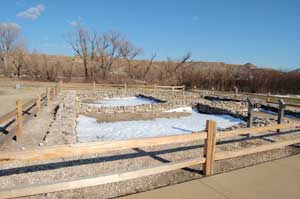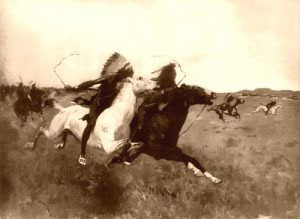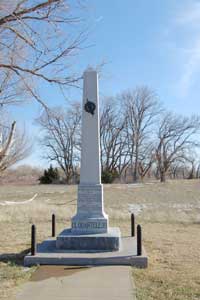The Quartelejo Ruins are the archaeological remains of the northernmost Indian pueblo and the only known pueblo in Kansas. Located on Ladder Creek in Lake Scott State Park, El Quartelejo means “far quarter” or “district” in Spanish.
Archaeologists believe this is the location of the village of Quartelejo, referred to in 17th-century Spanish reports. This site was named when the Plains Apache Indians first inhabited it. The stone pueblo is thought to have been built by Taos Pueblo Indians who left New Mexico in 1664 to escape Spanish rule. However, a Spanish expedition led by Lieutenant Juan de Archuleta soon chased down the Pueblo Indians and returned them to Taos.
After the Pueblo Revolt, another Pueblo group, the Picuri, fled from the Spanish and resettled El Quartelejo in 1696. However, a decade later, they were found by Spanish General Juan de Ulibarrí and 40 soldiers in 1706, and were also returned to New Mexico.
Several reports in the years that followed stated that Frenchmen were attempting to trade with the Apache of the Quartelejo and other Plains Indians. To protect their claim upon the Great Plains, the Spanish sent Pedro de Villasur from Santa Fe with 40 Spanish soldiers and about 60 Indian allies to check New France’s growing influence in the area in 1720. After passing through El Cuartelejo and making their way to Nebraska, they were attacked by the Pawnee and Otoe Indians, who killed 36 of the Spaniards, 10 of their Indian allies, and a French guide. The survivors then retreated to New Mexico. Reportedly, the attack was made at the urging of the Frenchmen.
By the 1730s, Comanche, Ute, and Pawnee raids had decimated the Quartelejo Apache, and the survivors moved south to join the Jicarilla Apache at Pecos, New Mexico.
By 1763, the French had retreated from the area, and the pueblo was abandoned with only a mound and a few irrigation ditches remaining. Eventually, its walls decayed, and the drifting soil buried the structure.
As American explorers made their way west, the pueblo was unknown to them. However, archeologists rediscovered El Quartelejo in 1898. Afterward, the site was excavated, revealing that the pueblo was a seven-room structure, enough to house a small band of Indians. Near the pueblo, traces of shallow ditches extend from the springs, likely used to irrigate crops in nearby fields.
In 1964, the El Quartelejo ruins were designated a National Historic Landmark. Several years later, the pueblo and the surrounding area were added to Scott Lake State Park in 1971. The outline of the ruins was then restored, and interpretive markers were placed. The site is owned and administered by the Kansas State Society, Daughters of the American Revolution.
Scott Lake State Park is located 12 miles north of Scott City, west of U.S. Highway 83.
The El Quartelejo Museum in Scott City focuses on local interests, from prehistory to the present day, and features many exhibits of fossils. A Pueblo Indian display, early Indian scenes, and a Pioneer homestead round out the historical displays offered. It is located at 902 W. 5th Street in Scott City, Kansas.
©Kathy Alexander/Legends of Kansas, updated October 2025.
Also See:
Sources:



